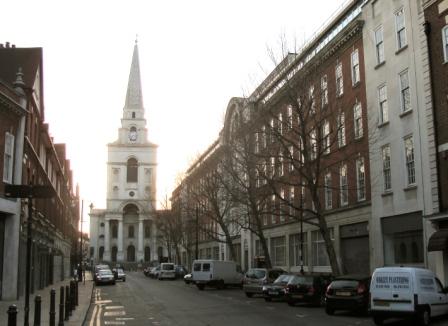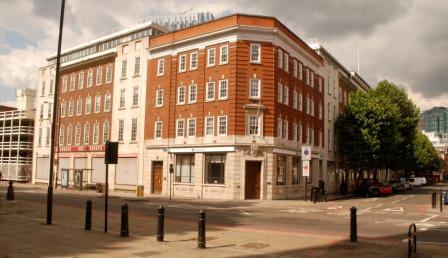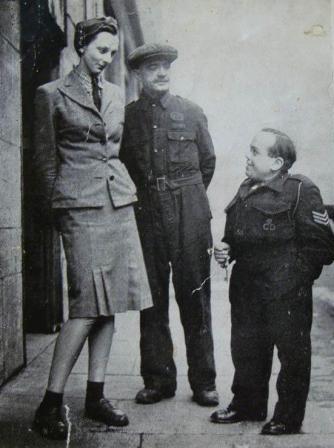Press Release: SAVE calls on Maria Miller to list the London Fruit and Wool Exchange
9th May 2013
SAVE appeals to Maria Miller, Secretary of State for Culture, Media and Sport, to overrule advice from English Heritage not to spot list the London Fruit and Wool Exchange.
SAVE applied to English Heritage in December 2012 with a thorough and extensive application to spot-list this handsome and significant ensemble of buildings on Brushfield Street, Spitalfields, following a decision from London Mayor Boris Johnson to demolish.
The site consists of the 1929 London Fruit and Wool Exchange, the Gun Pub and a Barclays' Bank. These were built by the then City Surveyor, Sidney Perks. He cleverly gave each of the three buildings their own distinctive character while making them part of a whole. The ensemble is in the Wrenaissance style, designed in sensitive response to one of the capital's great churches, Hawksmoor's Christchurch, that presides over the street.
The view of Christ Church Spitalfields from Bishopsgate along Brushfield Street is one of the most important and finest architectural vistas in London, framing an undoubted masterpiece which rivals any of the great Baroque churches on the Continent, including those in Rome itself.
The respect that has been shown towards this vista by the City's Surveyor, Sydney Perks, and thereby the City Corporation itself, is significant historically as a piece of town planning. Sydney Perks designed buildings on both sides of the street towards the east end of Brushfield Street. It took a major conservation battle to secure the preservation of his delightful chain of market offices on the north side of Brushfield Street, which were ultimately carefully repaired and cleaned by Norman Foster in his major development on the market site.
We pointed out to English Heritage in our application that the Wrenaissance style gave the capital some of its best and most prominent late Victorian and early 20th-century buildings and landmarks.
Both the craftsmanship and the materials used on the elevations are all of consistently good quality and are all the more significant and notable for having been so well maintained during their lifetime. The elevations are in near pristine condition.
The present proposals are to retain the façade on Brushfield Street, while the rest will be demolished to make way for offices, and an additional storey will be added. This means the interiors with their auction rooms will be lost despite the fact that they are remarkably complete and unaltered, and the open plan parts of the building would make ideal offices.
The survival of the London Fruit and Wool Exchange has taken on an added significance following the destruction of other architecturally significant exchanges in the City, notably the Coal Exchange and the Baltic Exchange, both of which were major architectural losses.
The site has major social history, being the biggest air raid shelter in the East End, organized by '"Mickey the Marshall," otherwise known as Mickey the Midget: "three feet six inches of reckless unconcern and tireless energy." The canteen was a gift of Marks and Spencers and could serve 5,000 people a night.
Eminent historians backed our application.
Historian Bridget Cherry writes: "The building as a whole has considerable value in providing a traditional and consistent streetscape of quality in the much changed Brushfield Street. In addition it is of great historical interest in retaining a largely unaltered interior with purpose-designed auction rooms, a rare survival of the City's concern with the marketing of goods rather than services. The destruction of the interior would seriously diminish the already much depleted historic character of the area."
The Spitalfields Community Group writes: "The Fruit and Wool is a fine building deserving protection both for its architecture and its social history. It enjoys a much loved place at the heart of Spitalfields. It represents an important, if less known, period in this ancient neighbourhood's history."
David Walker, former Head of Listing at Historic Scotland, notes that this is a rare building type: "there is nothing in Scotland on this scale, and no comparable auction hall. We would therefore have listed it both as architecture and as the prime example of a specialised building type, which was very restricted in numbers from the beginning. In this particular instance the early 18th century style facades have especial importance as a sympathetic setting for Christ Church. In that respect the brick facades have even more value than the neo-Hawksmoor centrepiece."
On the social significance of the building historian Dan Cruickshank writes: "Essentially the Government had not - for ideological reasons - provided adequate deep-shelters for the East End population that was, of course, in the front-line of the German bombing campaign. Churchill and others feared a 'deep-shelter' mentality emerging, meaning that working men and women would cower in deep shelters - if they were provided once the bombing started and fail to go to work. Very patronising. So the people had to help themselves - and this is what Mickey did, choosing a modern building of steel frame and concrete construction and with a deep basement. His shelter in the Fruit & Wool Exchange became something of a model for large public shelters - eventually very well organised. It also became something of a landmark - visited by the Soviet and US ambassadors."
SAVE President Marcus Binney says: "The Exchange frames the finest vista of any church of London - the view of Hawksmoor's masterpiece Christ Church Spitalfields from Bishopsgate and the City. The Corporation's Surveyor designed a whole island block to complement the church, with matching market buildings on the other side of the street - just in the way that St Paul's Cathedral was surrounded by warm red brick houses in Christopher Wren's London. Preserving just one façade of a building with four show fronts and an interior which is complete apart from the woodwork of the auction rooms will be a pathetic example of tokenism. Maria Miller should stand up for the Exchange in the way her courageous predecessor Geoffrey Rippon stood up for historic buildings in Covent Garden, with results that delight everyone to this day"
Notes to Editors:
The term Wrenaissance appears to have been coined by Lutyens; the finest examples include the Country Life offices in Tavistock Street - inspired by Wren's Hampton Court Palace - and Lutyens's Midland Bank in Piccadilly. Both of these are listed Grade II*.
For more images please contact SAVE on office@savebritainsheritage.org
70 Cowcross Street London EC1M 6EJ
T: 020 7253 3500 F: 020 7253 3400 E: office@savebritainsheritage.org
www.savebritainsheritage.org
Registered Charity 269129



